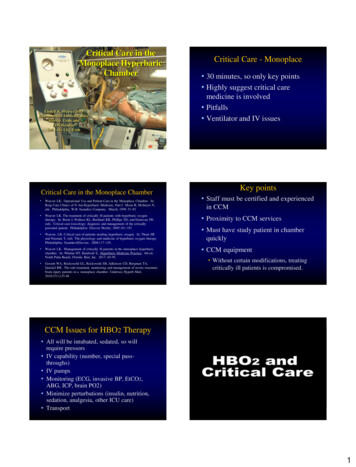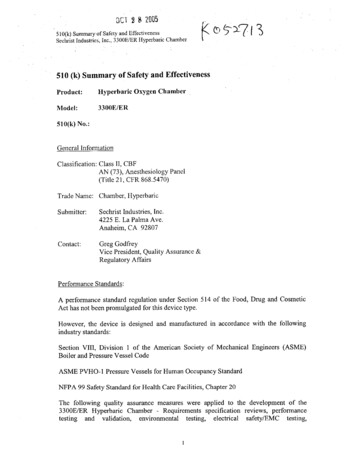
Transcription
Critical Care in theMonoplace HyperbaricChamberLindell K. Weaver, MDIntermountain Medical CenterMurray, Utah, andLDS HospitalSalt Lake City, UtahCritical Care in the Monoplace Chamber Weaver LK. Operational Use and Patient Care in the Monoplace Chamber. In:Resp Care Clinics of N Am-Hyperbaric Medicine, Part I. Moon R, McIntyre N,eds. Philadelphia, W.B. Saunders Company, March, 1999: 51-92 Weaver LK. The treatment of critically ill patients with hyperbaric oxygentherapy. In: Brent J, Wallace KL, Burkhart KK, Phillips SD, and Donovan JW,(ed). Critical care toxicology: diagnosis and management of the criticallypoisoned patient. Philadelphia: Elsevier Mosby; :181-187. Weaver, LK. Critical care of patients needing hyperbaric oxygen. In: Thom SRand Neuman T, (ed). The physiology and medicine of hyperbaric oxygen therapy.Philadelphia: Saunders/Elsevier, :117-129. Weaver LK. Management of critically ill patients in the monoplace hyperbaricchamber. In: Whelan HT, Kindwall E., Hyperbaric Medicine Practice, 4th ed.North Palm Beach, Florida: Best, Inc. 65-95. Gossett WA, Rockswold GL, Rockswold SB, Adkinson CD, Bergman TA,Quickel RR. The safe treatment, monitoring and management of severe traumaticbrain injury patients in a monoplace chamber. Undersea Hyperb Med.;37(1):35-48Critical Care - Monoplace 30 minutes, so only key points Highly suggest critical caremedicine is involved Pitfalls Ventilator and IV issuesKey points Staff must be certified and experiencedin CCM Proximity to CCM services Must have study patient in chamberquickly CCM equipment Without certain modifications, treatingcritically ill patients is compromised.CCM Issues for HBO2 Therapy All will be intubated, sedated, so willrequire pressors IV capability (number, special passthroughs) IV pumps Monitoring (ECG, invasive BP, EtCO2,ABG, ICP, brain PO2) Minimize perturbations (insulin, nutrition,sedation, analgesia, other ICU care) Transport1
IV Therapy (9 tanylBicarbFFPKCl, Mg, CaLRIV Pass-throughsNo longer availableSechrist Sechrist and No FDA cleared infusion pumps foruse with monoplace or multiplacechambers Two infusion pumps will work: Zyno Medical Z-800F Baxter Flo-Gard 6201 infusion pumpsMaxim Maxim removable backcheck valve sowe can sampleblood Dead space: Sechrist – 8cc Maxim – 6ccINTRODUCTIONRay D, et al. Baxter Flo-Gard 6201 Volumetric Infusion Pump for Monoplace Chamber Applications.UnderseaHyperb Med ;27(2):107-111.Weaver LK, et al. Comparison of Three Monoplace Hyperbaric Chamber Intravenous Infusion Pumps.Undersea Hyperb Med ;32(6):451-6.Bell J, et al. Performance of the Hospira Plum A (HB) hyperbaric infusion pump. Undersea Hyperb Med; 41(3):235-43.MaximMATERIALS AND METHODSMATERIALS AND METHODS Occlusion pressurewas adjusted for allthree pumps Pump flow accuracywas tested for themonoplacehyperbaric chambersat different rates,pressures, andvolumesBaxterZyno2
Results: Monoplace 3 ATAResults / Monoplace 3 ATAResults Monoplace 1 ml/hr COprofileResults monoplace 10 ml/hr COprofileIV Performance – Tubing ComplianceMeasured Fluid Volumes (ml) at 3.0 atm abs During Compression and CumulativeCompression/DecompressionFluid Volume (ml)Compression 10 min43.532.521.510.50-0.5Compression/Decompression 20 min3.61.64-0.020.3410.60.15Flow Rate [ml/hr]10Weaver LK, et al. Comparison of Three Monoplace Hyperbaric ChamberIntravenous Infusion Pumps. Undersea Hyperb Med ;32(6): 451-6.3
IV Administration Issues IV tubing compliance Lack of drug administration for morethan 10 minutes with HBO2 compression Bolus during decompressionA Solution to Tubing Compression Hard tubingplumbed from thedoor of the pump tothe chamber Use Baxter pumpfor very low rates Pull IV set up asfar as possibleWeaver LK, et al. Comparison of Three Monoplace Hyperbaric ChamberIntravenous Infusion Pumps. Undersea Hyperb Med ;32(6): 451-6.IV, 5 or more lines Custom IV PenetratorsSalineLevophedInsulinFentanylPropofol (“propofed”)Ventilator IssuesSechrist 500AVentilator Marginal in performance, antiquated infunction No assist modes No alarms Limited Options Sechrist 500A Omni-vent (Max O2, Magellan, Atlantis) Atlantis (based on Omni-vent)SpirometerAirway PressureFlowE-timeI-timeNebulizer(we omit)4
Sechrist 500A performanceP 55psig-50Δ Vt(%)High Pressure Gases forOptimal Ventilator OperationBETTER!P 85psig-10Manifold (85 psig)PCH (ATA)Source (140 psig)Weaver, et al. JHyperMed 1988Ventilator LimitationsSechrist 500A 15 l/m if PEEP 10cm H2O at 2.4 atm absWeaver LK, et al. Performance of the Sechrist 500AHyperbaric Ventilator in a Monoplace HyperbaricChamber. J Hyperbaric Med 1988;3(4):215-225.Omni-Vent (Max O2or Magellan)22 l/m at 3 ATAMonitor RR, Vt!!Churchill S, et al. Performance of the Omni-vent MechanicalVentilator for use with the Monoplace HyperbaricChamber. Undersea Hyper Med 1999;26(Suppl):70-71.Sechrist-80 psiOmniVent-120 psiOmni-Vent (Magellan); 3 ATASeptic shock, PP 22 cm H2OMechanical Ventilation Concerns Air-trapping and hyper-expansion are risks,and seen often with VE 15 l/m, PP 5 cmH2O Attempts to maintain VE prolong I-time,invert I/E, and stack breaths Result: decreased BP, pneumothorax, AGE If decrease RR to increase E-time, reduceair-trapping, but PaCO2 increases (CNS riskfor O2 toxicity and increase in ICP)5
PEEP and the Intubated PatientPEEP Valve – CPAP ValvesVital Signs, Inc. Totowa, NJ If patient needs 40% O2, will need PEEP andhigher chamber pressures to have PaO2 values 1000 torr and brain PO2 150 torr.If PaO2 is lower than desired, elevate by: Increasing chamber pressure (per allocation)Increasing PEEPImproving lung function (bronchodilators,suctioning, diuresis)Reducing CaO2 – CvO2 (dobutamine?)500 A does NOT give 100% O2!500 A does NOT give 100% O2!Entrainmentvalve entrainsambient gas (air,until thechamber fillswith oxygen: 15minutes)Ambient gasAir Breathing & Mechanical Ventilation(We rarely provide air breathing unless specified by protocol)Anesthesia bagfilled externallyOne-way pop-off toprevent over-inflationWeaver LK. Management of Critically Ill Patientsin the Monoplace Hyperbaric Chamber. In:Kindwall EP, Whelan HT, eds., HyperbaricMedicine Practice, 2nd ed. Flagstaff, AZ: Best,Inc. 1999;245-294.6
Sedation for HBO2 HBO2 & CCM MonitoringVentilator asynchrony is expectedDeep sedation and analgesia Fentanyl/Remifentanyl infusion Propofol infusion Levophed (“PropoFed”) Alternative (e.g. Morphine /or Ativan)Paralysis? Prefer none, but if ventilatorasynchrony is pronounced, and gas exchangeis affected, paralyze (Vecuronium, Cisatricurium if renal insufficiency).S-G, Vent, PEEP, SuctionTcO2 TcCO2ECGARTRVPASvO2QtEtCO2Multiple gas pass-throughEtCO2Spirometer PEEP ManometerCanisterAnesthesiaBagSuctionSuctionVent supplyS-GPan-America HyperbaricsOxygenation Monitoring During HBO2 Arterial blood gases:We perform measurements routinely to assessarterial CO2 and O2 tensions (ABL 525) Transcutaneous O2 and CO2?Often accurate, occasionally highly inaccurate.Arterial Blood Gases7
Blood gas samplingRadiometer - ABL 800Blood is 30% lower than predictedABG sampleDeadspaceDeadspaceHypoxemia During HBO2Hypoxemia with air, Table 6PaO2 346 torr(expected 1500torr)66 y/o female, AGE following IJ CVC removal.Hypoxemia with air at 1.9 ata (30 fsw).Weaver LK, Larson-Lohr V. Hypoxemia During Hyperbaric Oxygen:A Case Report. CHEST 1994;105:1270-1271.Can transcutaneous (PtcO2)replace PaO2?Not alwaysWeaver, Churchill. Hypoxemia with air breathing, US Navy TT6.UnderseaHyperbMed.PtcO2 and PtcO2 v. PaO2 and PaCO210 healthy subjectsUHM 19998
Myringotomies: Intubated PatientsRequired in HOBITMyringotomies: Intubated Patients Variable, some do them, others do not We did them routinely until 1992, thenstopped because of CO RCT and surveyresults (of 20 centers half did them and halfdid not). No apparent damage to inner ear Patients need to be deeply sedated forcompression Study warrantedPEEP, sedation, paralysisHypotension Compression – insufficient pressors At pressure Auto-peep Sepsis Pressor dosing Decompression – Auto-peep, increasingtidal volume, pneumothorax Anytime – sedation level, esp. propofol(Improve oxygenation) Auto-PEEP is common. If BP falls during HBO2, often due to auto-PEEPWe increase PEEP to improve lung functionRecruitment (PEEP) before HBO2Sedation (Fentanyl, Ativan, Propofol)Propofol: have levophed ready (“propofed”)Paralysis – rarely, but do this if PaO2marginal and HBO2 continuedCardiac Arrest and HBO2 66 y/o female, AGE following IJ CVC removal, severehypoxemia. Arrest with dropping PaO2 as chamberdepressurized. Prolonged CPR. Brain injury, died days later(published).60 y/o female, epidural spinal abscess, CRF, shock, levophed,epi; VT – synch cardioversion. MOF, withdrawal days later.55 y/o female, DM, chest wall necrotizing fasciitis, shock,pressors, cardiac arrest: emergent decompression, Defibunsuccessful, pulled chest dressings off, Defib again in thewound, successful. MOF, withdrawal days later.Breast Ca, XRT, chronic chest wound, Aortic stenosis, stableheart failure; 3rd HBO2, acute lung edema OK; HBO2resumed, acute lung edema, then arrest, died (published)Mortality and APACHE IIDiagnosis (n)APACHEIIMortality(%)PredictedMortality (%)45AGE/VGE (5)2940Osteomyelitis (2)2610040Necrotizing Fasc. (45)231142Acute Ischemia (3)223330Mucormycosis (2)225030Crush (8)Gas Gangrene (6)0CO/Cyanide (13)17825Failing Flaps (3)160159
